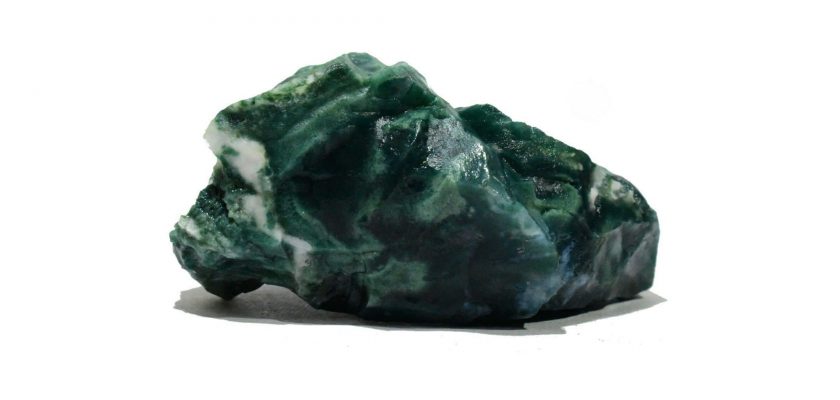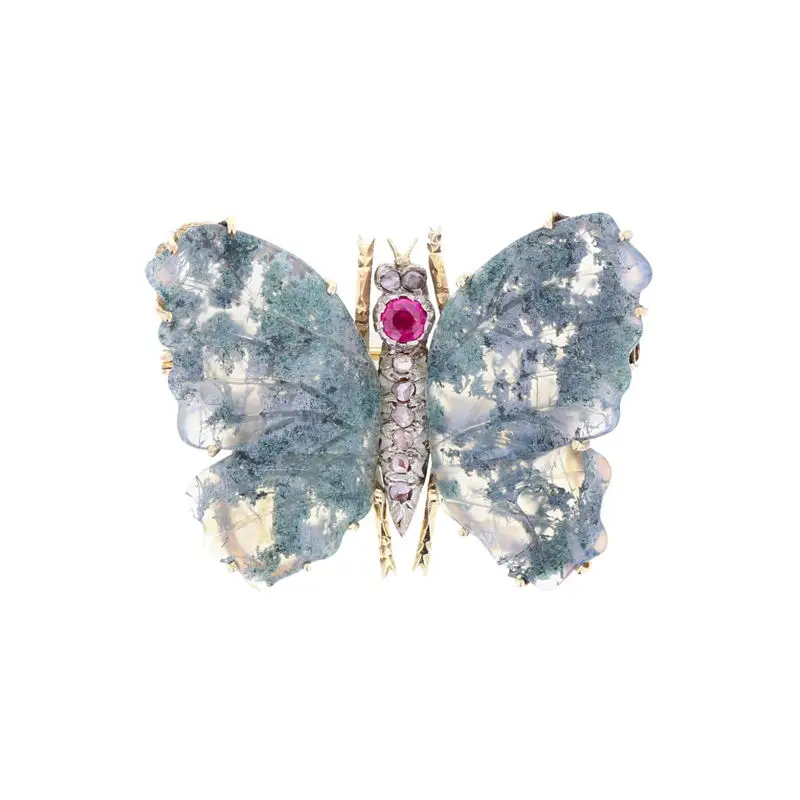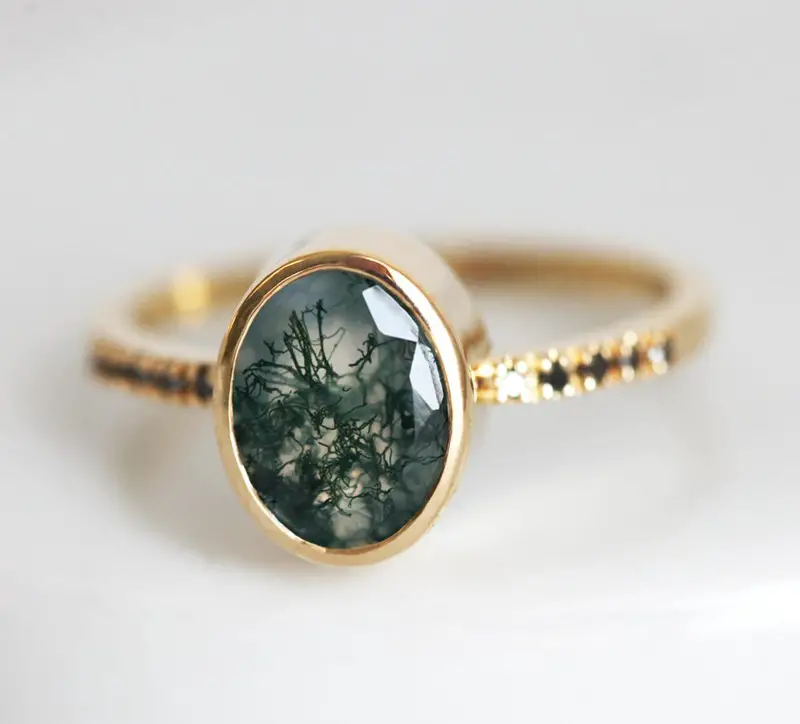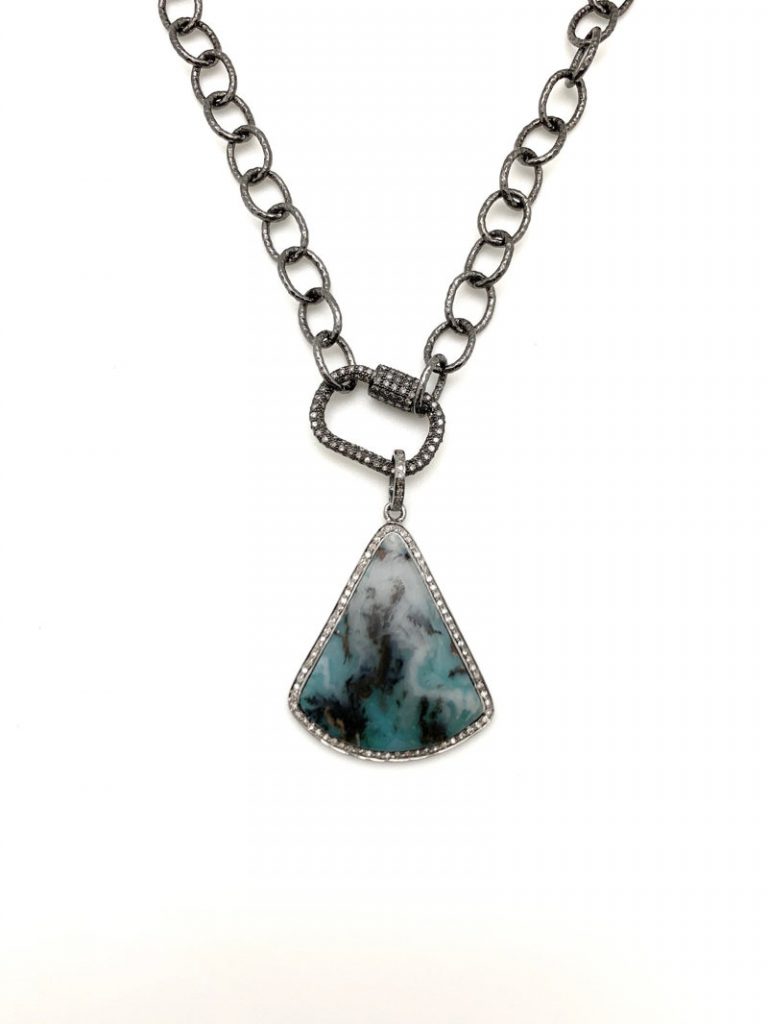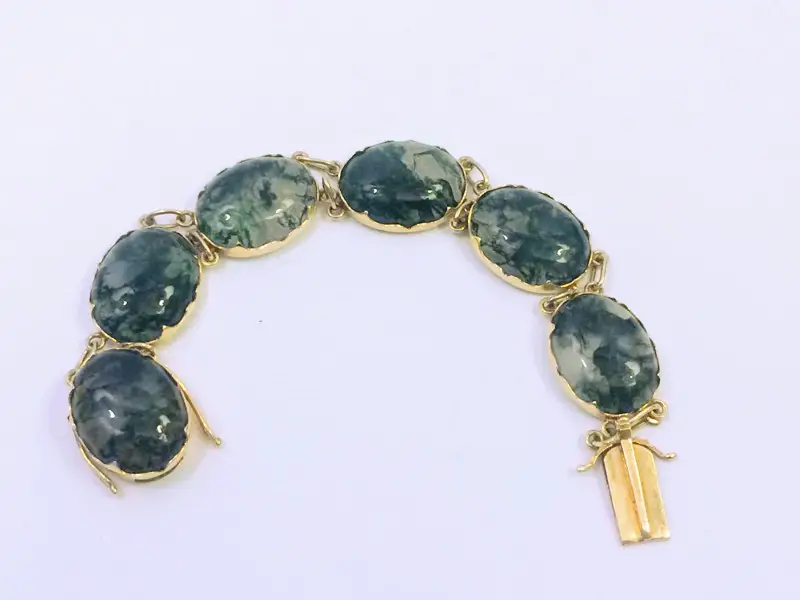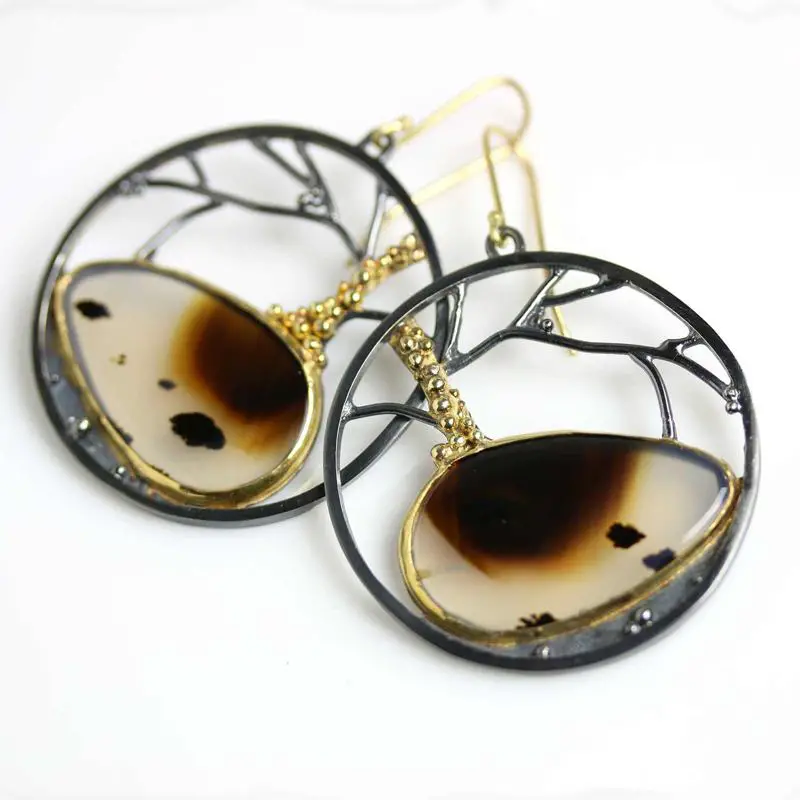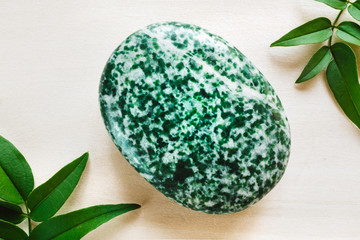Moss Agates are quartz-based gemstones similar to chalcedony. Similar to the Tree Agate, these stones are not banded and are not considered true agates based on the scientific definition. Moss Agates are commonly confused with Tree Agates as they are both dendritic gemstones with the main difference between the two being their hardness and the mineral contents contained within the dendritic formations.
The dendritic formations within the stone resemble that of moss and lichen growths. The dendrite formations typically consist of iron and manganese, occasionally revealing red spots. The stone itself is generally clear to milky white, with some stones having green and blue hues as well. Fans of gardening often use Moss Agates by mixing them in the soil to promote growth and plant health.
This post is all about what you want ever to know pertaining to Moss Agate. If you find it useful, don’t forget to share. Let’s get it started!
Meaning
Depending on where the stone is excavated, the Moss Agate, similarly to Tree Agate can sometimes be referred to as Mocha Stone, a reference to the port city of Mocha in Yemen. Tree Agates are also sometimes referred to as Mocha Stone, possibly due to the similarities between both stones. There also exists some dispute over which stones actually should be called Mocha stones with some believing that the name is reserved only for gemstones with brown or red coloring.
Like many other gemstones, Moss Agate is commonly used for jewelry and ornamentation. The stone is valued for its uses as a healing stone and in the 18th century, Britain was considered a symbol of good luck and was used widely as a good luck charm when used in jewelry. Some history also describes farmers in Europe using the stone to hang from trees around their crops and attaching them to the horns of work animals such as oxen to help bring good luck and improve crop yields. In ancient cultures, tribal priests would use the stone as a healing stone and would be crafted it into talismans that soldiers would wear to make them stronger and bring victory in battle.
Properties
Physical Properties
Moss Agates are not technically true agates due to the non-banded formation of the stone that does not contain any organic matter as the name might allude to. The stones are semi-translucent and generally have a milky white appearance, but are also known to have green and blue colors in their inclusions. The dendritic formations in this stone resemble lichen and moss formations and are comprised of oxide inclusions of iron and manganese that vary in color depending on trace inclusions of other minerals and metals. Like true agates, the stone is primarily composed of quartz and is a member of the chalcedony group of minerals which includes stones like onyx and jasper.
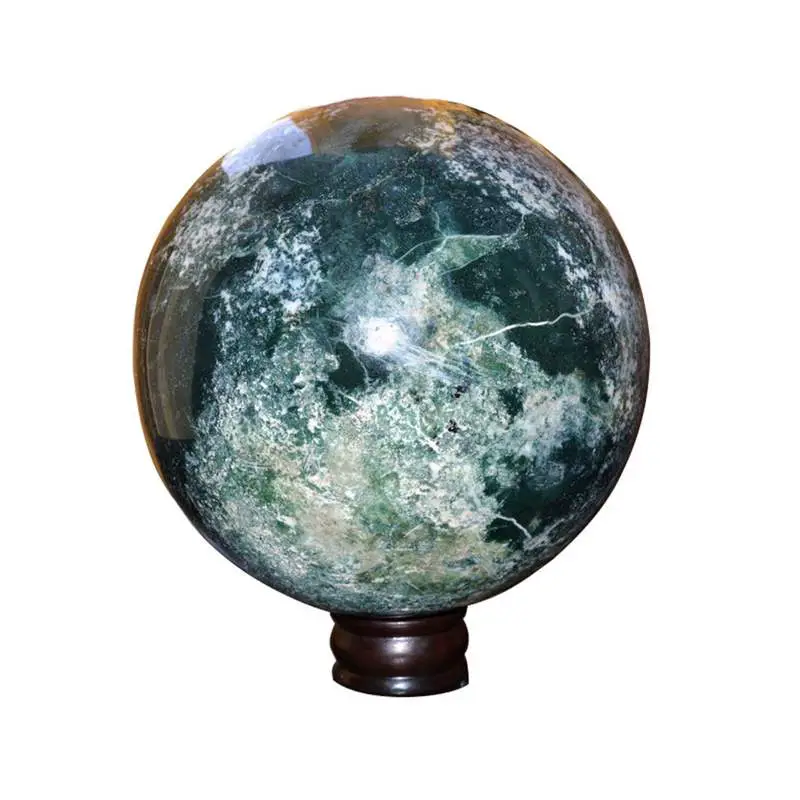
The quartz that makes up the structure of the moss agate is considered a silicate and has the chemical composition of SiO2 (Silicate Dioxide), the primary chemical of all chalcedony and silicates. Silicates like that contained in Moss Agates are often used in the production of glass and make for excellent material when making jewelry and pendants. The hardness of these stones is similar to most members of the chalcedony group possessing a hardness of 6.5 to 7 on the Mohs scale. Stones with a Mohs rating of less than 7 are usually recommended to be kept away from other stones when put in storage due to how easily they can be chipped or scratched from other stones and minerals.
The specific gravity of the stone can range between 2.58 and 2.62. The measure of gravity[wiki] or relative density measures the difference between the stone’s weight in the air when compared to the weight of an equal volume of water. Stones with a higher gravity exhibit a heavier weight in comparison to objects with a lower gravity but similar size. The relative gravity of water, when used in determining relative gravity, is 1 gram per cubic centimeter.
The Moss Agate has a refractive index of 1.54-1.55, meaning that light travels through the stone at 1.54-1.55 times as fast in a vacuum. The stone can be found in many areas around the world, including regions of Australia, Russia, India, and The United States.
Metaphysical Properties
The Moss Agate has a number of metaphysical properties that exhibit properties conducive to healing, luck, and nature. It is associated with the Heart Chakra, the fourth primary chakra. The Heart Chakra is associated with the color green, which in tandem with the Moss Agate, represents the color of healing and balance. This relationship between the stone and chakra also demonstrates healing properties that specifically affect the heart, upper back, and lower lungs. This gemstone is affiliated with the zodiac sign Virgo, the astrological sign for those born between August 24 and September 23 and is associated with the Moon planetary body and has an elemental affiliation with the earth.
This stone’s healing properties and positive properties include the promotion of plant fertility, restoration, and new beginnings. It has the ability to refresh the soul and assist in the development of new friendships and relationships. Moss agates can also aid in accelerating the healing process when recovering from illness and can also boost the immune system and help in cleansing the body’s circulatory system. Spiritually, this stone is useful for cleansing the soul and inspiring creativity and new ideas. When used in the workplace, Moss Agates can help draw more business and is especially helpful for small businesses or the self-employed. When used in gardening or farming settings, the stone is thought to promote growth and wildlife as well.
In midwifery, the stone can be used to assist in the birthing process by reducing the pain and relaxing the muscles to aid and ease the pain. Native American cultures also used the stone to practice cloud-busting and affect weather patterns. The cleansing properties of this stone are also useful when dealing with addiction recovery, mental illness, and chronic illness.
To best promote the metaphysical properties, the Moss Agate can either be held or kept close on its own or worn in a variety of jewelry such as amulets, rings, or bracelets. When worn or kept close to the body, this stone can be used to calm and sedate the brain’s energies, positively relieving the symptoms of stress, depression, mood swings, and poor concentration.
Where to Buy Moss Agate?
Usually Etsy or Amazon is a good idea. Etsy is the leading online global marketplace of handmade, vintage, and creative goods. Amazon is one of the largest global online marketplaces. Both of them are reliable and easy to find your favorite items there.
Moss Agate in Jewelry Uses
Moss Agates have an extensive history in the use of ornaments and jewelry. Stones that have a broad, white background can resemble a forest with fallen snow, or conversely resemble forest floors. White backgrounds can be enhanced by pairing with clear quartz. This stone adds a calm and quiet pattern when used in jewelry and can be paired with other stones to enhance its metaphysical properties as well as its aesthetic qualities. This stone is versatile and can be used in virtually any form of jewelry including rings, earrings, amulets, and more. The stone can also be produced into beads to further enhance its applications and usage in jewelry.
Historically, when used as a talisman, Moss Agates were worn by warriors to promote strength and victory as well as protection from natural hazards such as exposure to poisons and venom. Amulets can be worn to ward off negative energies and physical dangers caused by nature such as high winds and lightning caused by the weather and to protect from unsafe sailing conditions when on the water or ocean. Additionally, when worn as a talisman or necklace, Moss Agates are what are considered ‘seeker transformer’ crystals and can function as compasses for the soul in directing the mind and spirit to new opportunities and positive change for the wearer.
There are many ways to purchase, make, and wear Moss Agate jewelry. Pendants can be purchased as is or worn as a necklace. Pendants can come in a variety of sizes, but most commonly are seen cut into a teardrop shape. These stones are also excellent when worn as earrings as they produce a quiet and calming appearance and aren’t too vivid or vibrant.
You can also find Moss Agate beaded jewelry including bracelets that combine with other stones and agates. This stone is also popular as a stone setting for rings, typically made of silver but is also fairly common in combination with wire. Occasionally, you can find some beautiful forms of wrist cuffs that incorporate the moss agate with rope, or hemp yarn and accompanying pearls or other gemstones and Buddhist symbolism.
When used in Feng Shui and home design, the Moss Agate embodies wood energy and enhances feelings of growth and expansion, health, and nourishment. This makes the stone especially effective when placed in any space reserved for eating, such as a dining room or in places where work or creativity is experienced, such as an office or hobby space. Wood energy is best exhibited by placing it in the East or Southeast sections of the room in which the positive effects are desired. To use this stone in home décor, try having stones in an ornamental bowl or container in which the gemstones are visible and accessible.
Where Does Moss Agates Come From?
Moss Agates can be found in many areas around the world in which chalcedony and quartz are mined. Some countries in which this stone is commonly found include Australia, The United States, Russia, and India. Like other forms of chalcedony and agates, this stone is typically found in its raw form as a nodule contained within volcanic rock formations. It can also be found in pebble form after it has been released after being freed by natural processes such as erosion.
The term ‘Mocha Stone’ is commonly attributed to dendritic agates that are mined and distributed by the port city of Mocha in Yemen, though in some instances refers specifically to dendritic agates that include reddish or brown colors in the dendritic inclusions. Due to the ambiguity created by the name Mocha Stone, Moss Agates can easily be confused with Tree Agates in addition to the similarities they share in appearance and formation. Here are several specific locations around the world where chalcedony and agates are found:
- The Souris Gravel Pit in Manitoba, Canada
- Aurangabad District in Maharashtra, India
- East Kazakhstan in Kazakhstan, Iran
- Amethyst Sage Mine in Humboldt County, Nevada
- Trapper Creek Mine in Big Horn County, Wyoming
How Much Is Moss Agate Worth?
All agates have their value determined based on the grade and quality of the stone, its rarity, and its size. Dendritic agates such as the Moss Agate are difficult to cut due to the irregular patterning caused by their dendritic formations, which makes it more difficult to cut than a typical, banded agate. A common method of assessing the value and quality of agates is “The 4 Cs” method consisting of an assessment of the stone’s color, cut, clarity, and carat each of which affects the overall value of the stone.
Moss Agates are typically milky white in color and are semi-translucent. Stones that contain green or blue colors in the inclusions are rarer and therefore worth more than the more common, milky white. Due to the difficulty and unique formations that vary for each stone, Moss Agates that are cut in unique ways to present landscape or tree floor semblances are worth significantly more.
The clarity value is affected by the level of translucency apparent in the stone as well as how vividly the colors are present or have vivid and detailed dendritic formations. The carat value increases the larger the size and weight of the stone are. Like most other agates, Moss Agates that don’t have any unique characteristics or cuts typically sell for about $0.50 per carat.
How to Identify Moss Agate?
The easiest way to identify Moss Agates is by the dendritic formations that resemble the shape of moss or lichen formations. The dendritic formations can vary in color depending on the presence of any trace minerals or metals. Moss Agates are frequently confused with Tree Agates due to their similar appearance and color.
The stones are differentiated by their specific patterning varying from moss and lichen-like for Moss Agates and sprawling, branching dendritic formations are the characteristic of Tree Agates. Where the stone is found can affect the color and assist in identification. Montana Moss Agate, for example, is redder in color due to the trace elements abundant in the Yellowstone River that feed into the stone during its dendritic formation process.
How to Use Moss Agate?
Moss Agates are highly versatile gemstones and can be crafted in just about any form of jewelry or accessory. Historically and currently, this stone has been commonly used as placement in amulets and talismans worn as a necklace around the neck. As with other agates, it can also be shaped and used as a placement for earrings and rings. Alternative ways to wear the stone are enhanced by the stone’s ability to be crafted into beads that can be strung along twine or other types of string to create necklaces and bracelets.
Wearers born under the Virgo sign can wear this stone as a means to enhance the metaphysical presence of the cosmic energies caused by the constellation’s influence. Since most stones are white with green inclusions, they can be paired very well with other shades of green whether it be from jewelry or clothing. Green is the color of the Heart Chakra, so wearing the stone close to the chest as opposed to other areas of the body can focus the stone’s positive energies to positively enhance the extremities and appendages governed by the Heart Chakra. Agates are also known as “Seeker Transformer” stones that are useful when being used by wearers seeking positive changes in their situation, health, or relationships.
How to Cleanse Moss Agate?
Moss Agates can be cleaned fairly easily by using a soft bristle brush in combination with warm and soapy water. You can find these materials in most standard gemstone cleaning kits. Use a polishing cloth or microfiber cloth to remove any excess soap or moisture from the stone after cleaning. After cleaning, it is important when storing the stone to keep it from being scratched or chipped, such as in a felt-lined jewelry box and to be kept separate from other stones and minerals.
The hardness of the stone can typically fall below 7.0 on the Mohs scale, making it especially vulnerable to chipping and damage when in contact with other stones and minerals. To cleanse and purify the spiritual energies of this stone you can smudge by burning cedar or pine. Avoid using caustic or harsh chemicals when cleaning the stone as they can tarnish or erode minerals contained within the dendritic inclusions, potentially affecting the stone’s color.
Moss Agate vs. Tree Agate
Though Moss Agates are commonly confused with Tree Agates, there are a number of differences that help to distinguish them from one another. One primary difference is in their opacity. Moss Agates are generally partially translucent while Tree Agates are opaque. Both consist of quartz and have green dendritic inclusions, though differently shaped with the Tree Agates being more sprawling and branch-like, while Moss Agates have more speckled, and spotted inclusions that resemble moss or lichen.
Both stones have strong metaphysical connections with nature and tranquility, though the Moss Agate has been used as symbols of power and victory for ancient tribal warriors whereas the Tree Agate has not been known to be used in that way, nor is the Tree Agate useful for protecting against violent weather and the elements. The two stones pair well together due to their physical and metaphysical similarities.
Click Here to Read the Guide of Tree Agate
What to combine with Tree Agate
This stone pairs well with the color green and stones that exhibit green coloring to enhance the metaphysical connections with nature, making it a good pair with Tree Agates due to their similarities in color and composition. The white, opaque coloring of the stone can be further emboldened by pairing it with clear quartz or other opaque, white stones.
This stone can also be paired well with other earthly hues such as yellow and brown. When used in jewelry placements, Moss Agate pair well with organic materials such as wood or bone. For a more calming effect and presence, the stone can be paired with stones with blue hues such as Lapis Lazuli or purple-hued stones like Amethyst.
Final Words
The Moss Agate is a beautiful stone that evokes a deeper connection with nature and creates a calming and tranquil presence. There are many metaphysical properties this stone exhibits that are inherently useful when dealing with mental health and addiction issues. The calming effects of the stone also make it useful when used in meditation and in therapeutic settings. The accessibility and cheap pricing for this stone allows it to be easily obtainable and can be a great gift idea for friends and loved ones. To purchase Moss Agates, you can find them sold online as stones, jewelry, or beads.
These stones have a lot of historical and cultural significance, both being used for healing as well as symbols are worn by tribal warriors. The stone was used in many cultures to protect against dangerous weather and to calm rough seas during ship travel. As a symbol of prosperity, these stones have also been used as good luck charms and for generating revenue growth. You can also use this stone in decoration in the home and Feng Shui to promote your home’s impact on nourishment and creativity depending on which room you place it in along the South or South-Eastern areas.
It is important to remember that the healing and metaphysical properties of Moss Agates and gemstones in general are not alternatives to treating current or pre-existing medical conditions and should not be used on their own or as a tool for self-diagnosis. Be sure to consult your physician to identify and properly treat health concerns. Moss Agates and other gemstones should be used as an additive or supplemental enhancement of health and overall well-being.

